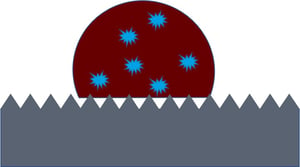Blood-repellent surfaces are needed in medical devices that come in contact with blood. These include implants that are placed in the human body, such as artificial valves and stents, and also medical devices that are used to handle blood outside the patient, for example, diagnostics, blood bags, and dialysis devices. The traditional approach has been the use of different types of antithrombotic surface treatments, such as heparin, to prevent blood coagulation. However, these coatings are prone to eventually wear off, exposing a blood incompatible surface underneath. Superhydrophobic surfaces have been proposed as an alternative solution. There the blood repellency is based on micro- and nanostructures instead of a biochemical coating. The current state of the art in this emerging approach is reviewed in a recent publication.
Superhydrophobic surfaces are defined as surfaces with a very high water contact angle (>150°), low contact angle hysteresis (< 10°) and a low sliding angle of a water droplet on a surface. These types of surfaces can repel water and even oil repellent surfaces have been developed. Blood brings in completely new challenges compared to pure liquids. Blood contains proteins, platelets, and cells, all of which have their own adsorption tendencies. For example, immune cells are biologically programmed to adsorb on foreign surfaces to protect the body from invasion.
The idea behind blood-repellency is at its core the same as with water-repellency: an air layer is used to shield the solid from making direct contact with blood. Superhydrophobic surfaces are always rough as the chemistry alone is not able to produce such a high contact angles. Even higher contact angles can be reached if air is trapped in between the liquid and the solid substrate. However, understanding and controlling the long-term effects of the contact between the gas trapped in the surface cavities and the blood remain as a potential challenge.
Several mechanisms for blood-repellence on superhydrophobic surfaces have been proposed. Most focus has been given to preventing platelet adhesion. Platelet adhesion is typically the first step for blood clotting and thus eliminating it or at least reducing it by nano- or combined nano/microstructures has shown promising results. The effect is twofold: first, the overall contact area is reduced which leads to a corresponding reduction in the number of adsorbed platelets. Second, if there are no solid areas that are platelet sized (2µm) or larger available, then the platelets cannot properly attach.
Superhydrophobic surfaces can also alter the shear flow patterns due to the slip phenomenon, which in turn can cause fewer platelets to adhere. Finally, the conformation of adsorbed proteins can be very different on nanoscale superhydrophobic surfaces (when the typical radius of curvature of the surface starts to be on the same scale as proteins). The types and conformation of adsorbed proteins is an important factor that affects platelet adhesion.
The concept of blood repellency by superhydrophobic surfaces is relatively new and thus the understanding of the mechanisms is constantly evolving. There are safety, stability and durability aspects that need to be solved before their use in implantable commercial product can be considered. However, medical devices, where safety is not so big issue, such as blood analysis, could be seen on the market sooner.
If you are interested in superhydrophobic surfaces and how to move them from lab to real life applications, please see the webinar below.
Single-cell trapping can be done with the help of superhydrophobic and superhydrophilic patterns.
Advancing and receding angles should be measured as the low contact angle hysteresis is also a requirement for superhydrophobicity.
Superhydrophobic surface is defined by having the static water contact angle above 150 ° and contact angle hysteresis less than 5 °.
There are three contact angle measurement methods for superhydrophobic surfaces; static, advancing/receding and roll-off angle.
A self-cleaning surface is any surface with the ability to readily remove any dirt or bacteria on it. Self-cleaning surfaces can be divided into three different categories; superhydrophilic, photocatalytic and superhydrophobic.
With increasing understanding of the superhydrophobicity, the measurement methods to quantify the degree of hydrophobicity deserve some thought.
This video will explain two main methods for measuring dynamic contact angle.
Superhydrophobic surfaces were an instant hit in the scientific community when they were introduced over two decades ago
Ville Jokinen (Ph.D) is a lecturer at Aalto University, School of Chemical technology. His research interests are microfabrication, wetting, microfluidics and superhydrophobicity and their chemical and biological applications.
